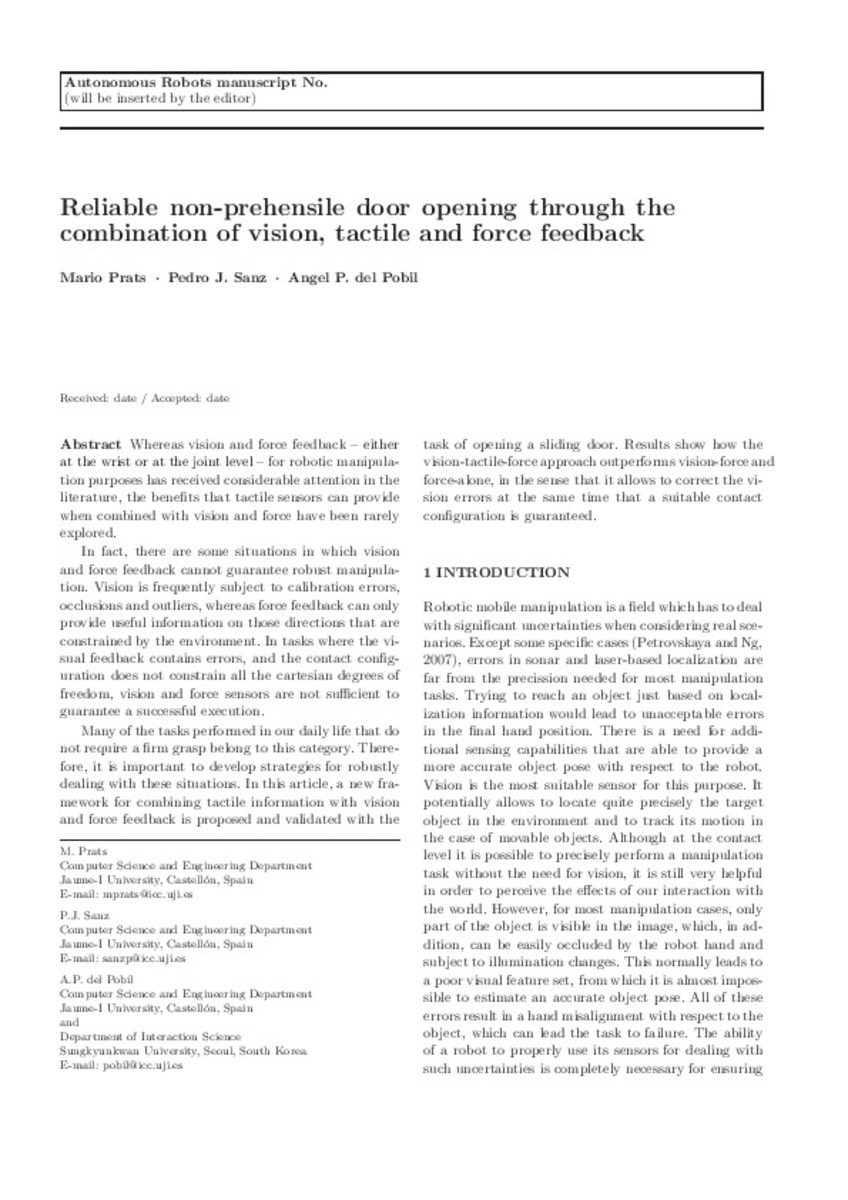Mostrar el registro sencillo del ítem
Reliable non-prehensile door opening through the combination of vision, tactile and force feedback
| dc.contributor.author | Prats Sánchez, Mario | |
| dc.contributor.author | Sanz, Pedro J | |
| dc.contributor.author | del Pobil, Angel P. | |
| dc.date.accessioned | 2011-07-25T09:21:47Z | |
| dc.date.available | 2011-07-25T09:21:47Z | |
| dc.date.issued | 2010-08-01 | |
| dc.identifier.issn | 0929-5593 | |
| dc.identifier.uri | http://hdl.handle.net/10234/26024 | |
| dc.description.abstract | Whereas vision and force feedback—either at the wrist or at the joint level—for robotic manipulation purposes has received considerable attention in the literature, the benefits that tactile sensors can provide when combined with vision and force have been rarely explored. In fact, there are some situations in which vision and force feedback cannot guarantee robust manipulation. Vision is frequently subject to calibration errors, occlusions and outliers, whereas force feedback can only provide useful information on those directions that are constrained by the environment. In tasks where the visual feedback contains errors, and the contact configuration does not constrain all the Cartesian degrees of freedom, vision and force sensors are not sufficient to guarantee a successful execution. Many of the tasks performed in our daily life that do not require a firm grasp belong to this category. Therefore, it is important to develop strategies for robustly dealing with these situations. In this article, a new framework for combining tactile information with vision and force feedback is proposed and validated with the task of opening a sliding door. Results show how the vision-tactile-force approach outperforms vision-force and force-alone, in the sense that it allows to correct the vision errors at the same time that a suitable contact configuration is guaranteed. | |
| dc.description.sponsorShip | This research was partly supported by the Korea Science and Engineering Foundation under the WCU (World Class University) program funded by the Ministry of Education, Science and Technology, S. Korea (Grant No. R31-2008-000-10062-0), by the European Commission’s Seventh Framework Programme FP7/2007-2013 under grant agreements 217077 (EYESHOTS project), and 248497(TRIDENT Project), by Ministerio de Ciencia e Innovación (DPI-2008-06636; and DPI2008-06548-C03-01), by Fundació Caixa Castelló-Bancaixa (P1-1B2008-51; and P1-1B2009-50) and by Universitat Jaume I. | |
| dc.language.iso | eng | |
| dc.publisher | Springer | |
| dc.relation.isPartOf | Autonomous Robots, vol. 29, n. 2 (2010), 201-218 | |
| dc.rights | The original publication is available at www.springerlink.com | |
| dc.rights.uri | http://rightsstatements.org/vocab/InC/1.0/ | * |
| dc.subject | Sensor-based manipulation | |
| dc.subject | Tactile sensing | |
| dc.subject | Service robotics | |
| dc.title | Reliable non-prehensile door opening through the combination of vision, tactile and force feedback | |
| dc.type | info:eu-repo/semantics/article | |
| dc.identifier.doi | https://doi.org/10.1007/s10514-010-9192-1 | |
| dc.relation.projectID | info:eu-repo/grantAgreement/EC/FP7/248497 | |
| dc.rights.accessRights | info:eu-repo/semantics/openAccess | |
| dc.relation.publisherVersion | https://link.springer.com/article/10.1007/s10514-010-9192-1 | |
| dc.type.version | info:eu-repo/semantics/submittedVersion |
Ficheros en el ítem
Este ítem aparece en la(s) siguiente(s) colección(ones)
-
ICC_Articles [414]







